Environmental issues in the United States
Environmental issues in the United States include climate change, energy, species conservation, invasive species, deforestation, mining, nuclear accidents, pesticides, pollution, waste and over-population. Despite taking hundreds of measures, the rate of environmental issues is increasing rapidly instead of reducing. The United States is among the most significant emitters of greenhouse gasses in the world. In terms of both total and per capita emissions, it is among the largest contributors.[1] The climate policy of the United States has big influence on the world.[2][3]
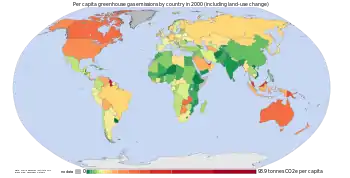
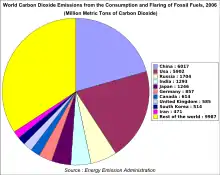
Movements and ideas
20th century
Both Conservationism and Environmentalism appeared in political debate in forests about the Progressive Era in the early 20th century. There were three main positions. The laissez-faire position held that owners of private property—including lumber and mining companies, should be allowed to do anything they wished for their property.[4]
The Conservationists, led by President Theodore Roosevelt and his close ally Gifford Pinchot, said that the laissez-faire approach was too wasteful and inefficient. In any case, they noted, most of the natural resources in the western states were already owned by the federal government. The best course of action, they argued, was a long-term plan devised by national experts to maximize the long-term economic benefits of natural resources.
Environmentalism was the third position, led by John Muir (1838–1914). Muir's passion for nature made him the most influential American environmentalist. Muir preached that nature was sacred and humans are intruders who should look but not develop. He founded the Sierra Club and remains an icon of the environmentalist movement. He was primarily responsible for defining the environmentalist position, in the debate between Conservation and environmentalism.
Environmentalism preached that nature was almost sacred, and that man was an intruder. It allowed for limited tourism (such as hiking), but opposed automobiles in national parks. It strenuously opposed timber cutting on most public lands, and vehemently denounced the dams that Roosevelt supported for water supplies, electricity and flood control. Especially controversial was the Hetch Hetchy dam in Yosemite National Park, which Roosevelt approved, and which supplies the water supply of San Francisco.
Climate change

_(PNG).png.webp)
Climate change in the United States refers to historical changes in the climate of the United States, as well as the regional climactic, economic, and cultural responses to global warming.
The current effects of global warming in the United States are widespread and varied. In 2012, the United States experienced its warmest year on record. As of 2012, the thirteen warmest years for the entire planet have all occurred since 1998, transcending those from 1880.[5][6] Different regions experience widely different climatic changes. Changes in climate in the regions of the United States appear significant. For example, drought conditions appear to be worsening in the southwest while improving in the northeast.[7] Generally, states that emit more carbon dioxide per person and block climate action, are suffering more.[8][9] Some research has warned against possible problems due to American climate changes such as the spread of invasive species and possibilities of floods as well as droughts.[10] Climate change is seen as a national security threat to the United States.[11]
The United States is among the most significant emitters of greenhouse gasses in the world. In terms of both total and per capita emissions, it is among the largest contributors.[12]
As of April 2019, 69% of Americans think that climate change is happening and 55% think that it is mostly human caused.[13]
In 2015, The New York Times and several other sources revealed that oil companies knew that burning oil and gas could cause global warming since the 1970s but, nonetheless, funded deniers for years.[14][15] 2016 was a historic year for billion-dollar weather and climate disasters in U.S.[16]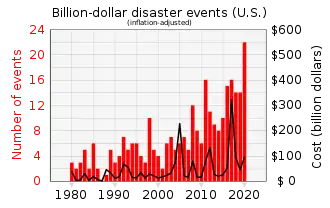
Energy
Since about 26% of all types of energy used in the United States are derived from fossil fuel consumption it is closely linked to greenhouse gas emissions. The energy policy of the United States is determined by federal, state and local public entities, which address issues of energy production, distribution, and consumption, such as building codes and gas mileage advancements. The production and transport of fossil fuels are also tied to significant environmental issues.
Species conservation
Many plant and animal species became extinct in North America soon after first human arrival, including the North American megafauna; others have become nearly extinct since European settlement, among them the American bison and California condor.[18]
The last of the passenger pigeons died in 1914 after being the most common bird in North America. They were killed as both a source of food and because they were a threat to farming. Saving the bald eagle, the national bird of the U.S., from extinction was a notable conservation success.
As of 13 December 2016, the International Union for the Conservation of Nature's Red List shows the United States has 1,514 species on its Threatened list (Critically Endangered, Endangered and Vulnerable categories).
Invasive species
Invasive species are a significant problem, some of the most notable being zebra mussels, Burmese pythons, kudzu, brown tree snakes and European starlings. Economic damages are estimated at $120 billion per year.
Deforestation
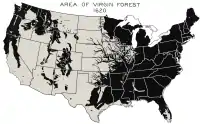

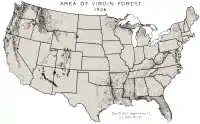
Deforestation in the United States was an ongoing process until recently. Between 2010 and 2020, the US forests increased 0.03% annually, according to FAO (Food and Agriculture Organization of the United Nations).[lower-alpha 1]
Prior to the arrival of European-Americans, about one half of the United States land area was forest, about 1,023,000,000 acres (4,140,000 km2) estimated in 1630. Forest cover in the Eastern United States reached its lowest point in roughly 1872 with about 48 percent compared to the amount of forest cover in 1620. The majority of deforestation took place prior to 1910 with the Forest Service reporting the minimum forestation as 721,000,000 acres (2,920,000 km2) around 1920.[19] The forest resources of the United States have remained relatively constant through the 20th century.[20] The Forest Service reported total forestation as 766,000,000 acres (3,100,000 km2) in 2012.[21][22][20] A 2017 study estimated 3 percent loss of forest between 1992-2001.[23]
The 2005 (FAO) Global Forest Resources Assessment ranked the United States as seventh highest country losing its old growth forests, a vast majority of which were removed prior to the 20th century.[20]Mining
| This article is part of series on the |
| Economy of the United States |
|---|
 |
|
United States portal |
Mining in the United States has been active since the beginning of colonial times, but became a major industry in the 19th century with a number of new mineral discoveries causing a series of mining rushes. In 2015, the value of coal, metals, and industrial minerals mined in the United States was US $109.6 billion. 158,000 workers were directly employed by the mining industry.[24]
The mining industry has a number of impacts on communities, individuals and the environment. Mine safety incidents have been important parts of American occupational safety and health history. Mining has a number of environmental impacts. In the United States, issues like mountaintop removal, and acid mine drainage have widespread impacts on all parts of the environment. As of January 2020. the EPA lists 142 mines in the Superfund program.[25]Nuclear

The most notable accident involving nuclear power in the United States was Three Mile Island accident in 1979. Davis-Besse Nuclear Power Station has been the source of two of the top five most dangerous nuclear incidents in the United States since 1979.[26]
Nuclear safety in the United States is governed by federal regulations and continues to be studied by the Nuclear Regulatory Commission (NRC). The safety of nuclear plants and materials controlled by the U.S. government for research and weapons production, as well those powering naval vessels, is not governed by the NRC.
The anti-nuclear movement in the United States consists of more than eighty anti-nuclear groups which have acted to oppose nuclear power and/or nuclear weapons in the USA. The movement has delayed construction or halted commitments to build some new nuclear plants,[27][28] and has pressured the Nuclear Regulatory Commission to enforce and strengthen the safety regulations for nuclear power plants.[29] Anti-nuclear campaigns that captured national public attention in the 1970s and 1980s involved the Calvert Cliffs Nuclear Power Plant, Seabrook Station Nuclear Power Plant, Diablo Canyon Power Plant, Shoreham Nuclear Power Plant, and Three Mile Island.[27]
Pesticides
Pesticide use in the United States is predominately by the agricultural sector, which in 2012 comprised 89% of conventional pesticide usage in the United States.[30]
The Federal Insecticide, Fungicide, and Rodenticide Act (FIFRA) was first passed in 1947, giving the United States Department of Agriculture responsibility for regulating pesticides. In 1972, FIFRA underwent a major revision and transferred responsibility of pesticide regulation to the Environmental Protection Agency and shifted emphasis to protection of the environment and public health.
Pollution
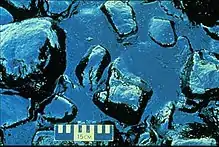
As with many countries, pollution in the United States is a concern for environmental organizations, government agencies and individuals.
Pollution from U.S. manufacturing has declined massively since 1990 (despite an increase in production). A 2018 study in the American Economic Review found that environmental regulation is the primary driver of the reduction in pollution.[31]Air pollution

Air pollution is the introduction of chemicals, particulate matter, or biological materials into the atmosphere, causing harm or discomfort to humans or other living organisms, or damaging ecosystems. Air pollution can cause health problems including (but not limited to) infections, behavioral changes, cancer, organ failure, and premature death. These health effects are not equally distributed across the U.S population; there are demographic disparities by race, ethnicity, socioeconomic status, and education. Air pollution has affected the United States since the beginning of the Industrial Revolution.
According to a 2009 report, around "60 percent of Americans live in areas where air pollution has reached unhealthy levels that can make people sick".[32] Analyzing data from 2016–2018, the American Lung Association found major declines in air quality, including increases in ground-level ozone.[33]
In 2016, a study found that levels of nitrogen oxides had plummeted over the previous decade,[34] due to better regulations, economic shifts, and technological innovations. NASA reported a 32% decrease of nitrogen dioxide in New York City and a 42% decrease in Atlanta between the periods of 2005–2007 and 2009–2011.Water pollution
(NRCS_Photo_Gallery).jpg.webp)
Water pollution in the United States is a growing problem that became critical in the 19th century with the development of mechanized agriculture, mining, and industry, although laws and regulations introduced in the late 20th century have improved water quality in many water bodies.[35] Extensive industrialization and rapid urban growth exacerbated water pollution as a lack of regulation allowed for discharges of sewage, toxic chemicals, nutrients and other pollutants into surface water.[36][37]
In the early 20th century, communities began to install drinking water treatment systems, but control of the principal pollution sources—domestic sewage, industry, and agriculture—was not effectively addressed in the US until the later 20th century. These pollution sources can affect both groundwater and surface water. Multiple pollution incidents such as the Kingston Fossil Plant coal fly ash slurry spill (2008) and the Deepwater Horizon oil spill (2010) have left lasting impacts on water quality, ecosystems, and public health in the United States.[38][39]
Many solutions to water pollution in the United States can be implemented to curtail water pollution. This includes municipal wastewater treatment, agricultural and industrial wastewater treatment, erosion and sediment control, and the control of urban runoff. The continued implementation of pollution prevention, control and treatment measures are used to pursue the goal of maintaining water quality within levels specified in federal and state regulations. However, many water bodies across the country continue to violate water quality standards in the 21st century.[40]Marine pollution
Plastic pollution
The United State is the biggest creator of plastic waste and the third largest source of ocean plastic pollution, e.g. plastic waste that gets into the oceans. Much of the plastic waste generated in the United States is shipped to other countries.[41]
Solid waste
At 760 kg per person the United States generates the greatest amount of municipal waste.[42] In 2018 municipal waste totaled 292.4 million short tons (265.3×106 t), or 4.9 pounds (2.2 kg) per person per day.[43]
Policy
Electronic waste

Electronic waste or e-waste in the United States refers to electronic products that have reached the end of their operable lives, and the United States is beginning to address its waste problems with regulations at a state and federal level. Used electronics are the quickest-growing source of waste and can have serious health impacts.[47] The United States is the world leader in producing the most e-waste, followed closely by China; both countries domestically recycle and export e-waste.[48] Only recently has the United States begun to make an effort to start regulating where e-waste goes and how it is disposed of. There is also an economic factor that has an effect on where and how e-waste is disposed of. Electronics are the primary users of precious and special metals, retrieving those metals from electronics can be viewed as important as raw metals may become more scarce[49]
The United States does not have an official federal e-waste regulation system, yet certain states have implemented state regulatory systems. The National Strategy for Electronic Stewardship was co-founded by the Environmental Protection Agency (EPA), the Council on Environmental Quality, and the General Services Administration (GSA), and was introduced in 2011 to focus on federal action to establish electronic stewardship in the United States.[50] E-waste management is critical due to the toxic chemicals present in electronic devices. According to the United States EPA, toxic substances such as lead, mercury, arsenic, and cadmium are often released into the environment and endanger whole communities; these toxic contaminants can have detrimental effects on the health of ecosystems and living organisms.[51] United States e-waste management includes recycling and reuse programs, domestic landfill dumping, and international shipments of domestically produced e-waste. The EPA estimates that in 2009, the United States disposed of 2.37 million tons of e-waste, 25% of which was recycled domestically.[51]Hazardous waste

Under United States environmental policy, hazardous waste is a waste (usually a solid waste) that has the potential to:
- cause, or significantly contribute to an increase in mortality or an increase in serious irreversible, or incapacitating reversible illness; or
- pose a substantial present or potential hazard to human health or the environment when improperly treated, stored, transported, or disposed of, or otherwise managed.
Under the 1976 Resource Conservation and Recovery Act (RCRA), a facility that treats, stores or disposes of hazardous waste must obtain a permit for doing so. Generators of and transporters of hazardous waste must meet specific requirements for handling, managing, and tracking waste. Through RCRA, Congress directed EPA to issue regulations for the management of hazardous waste. EPA developed strict requirements for all aspects of hazardous waste management including the treatment, storage, and disposal of hazardous waste. In addition to these federal requirements, states may develop more stringent requirements or requirements that are broader in scope than the federal regulations.
EPA authorizes states to implement the RCRA hazardous waste program. Authorized states must maintain standards that are equivalent to and at least as stringent as the federal program. Implementation of the authorized program usually includes activities such as permitting, corrective action, inspections, monitoring and enforcement.Population
The total U.S. population crossed the 100 million mark around 1915, the 200 million mark in 1967, and the 300 million mark in 2006 (estimated on Tuesday, October 17).[52][53] The U.S. population more than tripled during the 20th century — a growth rate of about 1.3 percent a year — from about 76 million in 1900 to 281 million in 2000. This is unlike most European countries, especially Germany, Russia, Italy and Greece, whose populations are slowly declining, and whose fertility rates are below replacement.
Population growth is fastest among minorities, and according to the United States Census Bureau's estimation for 2005, 45% of American children under the age of 5 are minorities.[54] In 2007, the nation’s minority population reached 102.5 million.[55] A year before, the minority population totaled 100.7 million. Hispanic and Latino Americans accounted for almost half (1.4 million) of the national population growth of 2.9 million between July 1, 2005, and July 1, 2006.[56]
Based on a population clock maintained by the U.S. Census Bureau, the current U.S. population, as of 5:55 GMT (EST+5) 27 April 2012 is 316,237,337.[57] A 2004 U.S. Census Bureau report predicted an increase of one third by the year 2050.[58] A subsequent 2008 report projects a population of 439 million, which is a 44% increase from 2008.
Conservation and environmental movement
Today, the organized environmental movement is represented by a wide range of organizations sometimes called non-governmental organizations or NGOs. These organizations exist on local national and international scales. Environmental NGOs vary widely in political views and in the amount they seek to influence the government. The environmental movement today consists of both large national groups and also many smaller local groups with local concerns. Some resemble the old U.S. conservation movement - whose modern expression is the Nature Conservancy, Audubon Society and National Geographic Society - American organizations with a worldwide influence.
See also
- Domestic policy of the George W. Bush administration - Environment
- Environmental policy of the Donald Trump administration
- List of environmental issues
- Mountaintop removal mining
- MTBE controversy
- Recycling in the United States
- United States offshore drilling debate
- Water pollution in the United States
Notes
- See FAO 2020, p. 18, table 8.
References
- EPA, OA, US (2016-01-12). "Global Greenhouse Gas Emissions Data | US EPA". US EPA. Retrieved 2018-06-13.
- "United States: Climate Policy". Encyclopedia.com. Retrieved 1 November 2020.
- McGrath, Matt (20 October 2020). "US election 2020: What the results will mean for climate change". BBC. Retrieved 1 November 2020.
- Samuelement, 1890-1920 (1959)
- There’s Still Hope for the Planet July 21, 2012 The New York Times by David Leonhardt
- By The Numbers: The U.S.'s Warmest Year Yet January 31, 2013 Popular Science
- Andreadis, K. M.; Lettenmaier, D. P. (2006). "Trends in 20th century drought over the continental United States". Geophysical Research Letters. 33 (10): n/a. Bibcode:2006GeoRL..3310403A. doi:10.1029/2006GL025711.
- Tollefson, Jeff (12 February 2019). "US climate costs will be highest in Republican strongholds". Nature. Retrieved 28 October 2020.
- "States Blocking Climate Action Hold Residents Who Suffer the Most From Climate Impacts". Climate Nexus, Ecowatch. October 29, 2019. Retrieved 31 October 2019.
- "Heat Waves, Storms, Flooding: Climate Change to Profoundly Affect U.S. Midwest in Coming Decades". Science Daily. January 18, 2013. Retrieved August 26, 2013.
- "Climate Change and US National Security: Past, Present, Future". atlanticcouncil.org. Atlantic Council. March 29, 2016. Retrieved September 21, 2016.
- EPA, OA, US (2016-01-12). "Global Greenhouse Gas Emissions Data | US EPA". US EPA. Retrieved 2018-06-13.
- Leiserowitz, Anthony; Maibach, Edward; Rosenthal, Seth; Kotcher, John; Bergquist, Parrish; Ballew, Matthew; Goldberg, Matthew; Gustafson, Abel. "Climate Change in the American Mind: April 2019". Yale Program on Climate Change Communication. Retrieved 2 October 2019.
- Egan, Timothy (November 5, 2015). "Exxon Mobil and the G.O.P.: Fossil Fools". The New York Times. Retrieved November 9, 2015.
- Goldenberg, Suzanne (July 8, 2015). "Exxon knew of climate change in 1981, email says – but it funded deniers for 27 more years". The Guardian. Retrieved November 9, 2015.
- Adam B. Smith (January 9, 2017). "2016: A historic year for billion-dollar weather and climate disasters in U.S." Climate.gov. Retrieved March 20, 2017.
- Smith, Adam B.; NOAA National Centers For Environmental Information (December 2020). "Billion-Dollar Weather and Climate Disasters: Overview / 2020 in Progress". NCDC.NOAA. National Centers for Environmental Information (NCDC, part of NOAA). doi:10.25921/stkw-7w73. Archived from the original on 10 December 2020. Retrieved 11 December 2020. and "Contiguous U.S. ranked fifth warmest during 2020; Alaska experienced its coldest year since 2012 / 2020 Billion Dollar Disasters and Other Notable Extremes". NCEI.NOAA.gov. NOAA. January 2021. Archived from the original on 8 January 2021.
- Pleistocene Megafauna Extinctions Archived 2010-03-08 at the Wayback Machine
- "Major Trends, Forest Inventory & Analysis, 2002" (PDF). United States Forest Service. Retrieved 2016-09-24.
- Forest Resources of the United States Archived May 7, 2009, at the Wayback Machine
- "Forest Facts, 2012" (PDF). United States Forest Service. 2014-08-31. Retrieved 2016-09-30.
- "National Report on Sustainable Forests — 2010". United States Forest Service. 2014-04-29. Retrieved 2016-09-24.
- Yin, Steph (2017-02-23). "How Far to the Next Forest? A New Way to Measure Deforestation". The New York Times. ISSN 0362-4331. Retrieved 2020-05-06.
- US Geological Survey, Mineral Commodity Summaries, 2016.
- US EPA, OLEM (2015-05-27). "Abandoned Mine Lands: Site Information". US EPA. Retrieved 2020-05-06.
- Nuclear Regulatory Commission (2004-09-16). "Davis-Besse preliminary accident sequence precursor analysis" (PDF). Retrieved 2006-06-14. and Nuclear Regulatory Commission (2004-09-20). "NRC issues preliminary risk analysis of the combined safety issues at Davis-Besse". Archived from the original on 2006-10-03. Retrieved 2006-06-14.
- Giugni, Marco (2004). Social Protest and Policy Change: Ecology, Antinuclear, and Peace Movements p. 44.
- Lights Out at Shoreham: Anti-nuclear activism spurs the closing of a new $6 billion plant Newsday.com, undated.
- Jerry Brown and Rinaldo Brutoco (1997). Profiles in Power: The Anti-nuclear movement and the Dawn of the Solar Age, p. 198.
- "US-EPA - Pesticides Industry Sales and Usage 2008-2012" (PDF). EPA.
- Walker, Reed; Shapiro, Joseph S. (2018). "Why Is Pollution from US Manufacturing Declining? The Roles of Environmental Regulation, Productivity, and Trade". American Economic Review. 108 (12): 3814–3854. doi:10.1257/aer.20151272. ISSN 0002-8282.
- "Top Polluted U.S. Cities With the World Air". ABC News. 2009-04-29.
- LaMotte, Sandee (21 April 2020). "Air quality in US dramatically worse, says new 'State of the Air' report". CNN. Retrieved 2020-04-21.
- Lloret, Javier; Valiela, Ivan (1 August 2016). "Unprecedented decrease in deposition of nitrogen oxides over North America: the relative effects of emission controls and prevailing air-mass trajectories". Biogeochemistry. 129 (1–2): 16563. doi:10.1007/s10533-016-0225-5. S2CID 99196860.
- Water Pollution Control: 25 years of Progress and Challenges for the New Millennium (Report). Washington, D.C.: United States Environmental Protection Agency (EPA). June 1998. EPA 833-F-98-003.
- Burian, Steven J.; Nix, Stephan J.; Pitt, Robert E.; Durrans, S. Rocky (2000). "Urban Wastewater Management in the United States: Past, Present, and Future" (PDF). Journal of Urban Technology. 7 (3): 33–62. doi:10.1080/713684134.
- Merchant, Carolyn (2007). American Environmental History: An Introduction. Columbia University Press. ISBN 978-0231140355.
- Bourne, Joel K. (February 19, 2019). "Coal's other dark side: Toxic ash that can poison water, destroy life and toxify people". National Geographic. Retrieved 2020-05-22.
- "Deepwater Horizon oil spill". Encyclopedia Britannica. Retrieved 2019-11-06.
- "National Summary of State Information". Water Quality Assessment and TMDL Information. EPA. Retrieved 2017-03-01.
- Rosane, Olivia (3 November 2020). "U.S. Leads the World in Plastic Waste, New Study Finds". Ecowatch.
- http://www.nationmaster.com/graph/env_mun_was_gen-environment-municipal-waste-generation Municipal waste generation
- "National Overview: Facts and Figures on Materials, Wastes and Recycling". EPA. 2020-11-10.
- "Michigan Solid Waste Policy 2007" (PDF). Michigan Department of Environmental Quality. May 2007.
- EPA. "Waste". Archived from the original on January 6, 2012. Retrieved January 17, 2018.
- Texas Commission on Environmental Quality. "Resources on Managing Municipal Solid Waste".
- Campbell, Katie (2016-05-10). "Where does America's e-waste end up? GPS tracker tells all". PBS News Hour. PBS. Retrieved February 28, 2017.
- "Electronic Waste (E-waste) Recycling Facts (2008)". Electronics TakeBack Coalition. 2008. Retrieved March 9, 2017.
- Namias, Jennifer. "The future of electronic waste recycling in the United States: Obstacles and Domestic Solutions." Columbia University. MS degree in Earth Resources Engineering Department of Earth and Environmental Engineering Columbia University July (2013).
- Used electronic products: An examination of US exports. Washington, D.C. USA: USITC. 2012. pp. 332–528.
- United States Environmental Protection Agency (2014-03-18). "Cleaning Up Electronic Waste". The Environmental Protection Agency. Retrieved February 28, 2017.
- "Statistical Abstract of the United States" (PDF). United States Census Bureau.
- "U.S. population hits 300 million mark". MSNBC (Associated Press). 2006-10-17. Archived from the original on 2006-10-17. Retrieved 2006-10-17.
- "Population Is Now One-Third Minority". Archived from the original on 2008-10-11.
- US Census Press Releases, U.S. Census Bureau
- "U.S. Census Bureau: Minority Population Tops 100 Million". Archived from the original on 2007-05-20.
- "U.S. Population Clock". U.S. Census Bureau. Archived from the original on 2011-02-23. Retrieved 2012-04-27.
- "Resident Population Projections by Sex and Age: 2010 to 2050" (PDF). United States Census Bureau. Archived from the original (PDF (455k)) on 2008-05-28. Retrieved 2008-04-29.
Further reading
- Bates, J. Leonard. "Fulfilling American Democracy: The Conservation Movement, 1907 to 1921", The Mississippi Valley Historical Review, (1957), 44#1 pp. 29–57. in JSTOR
- Brinkley, Douglas G. The Wilderness Warrior: Theodore Roosevelt and the Crusade for America, (2009) excerpt and text search
- Cawley, R. McGreggor. Federal Land, Western Anger: The Sagebrush Rebellion and Environmental Politics (1993), on conservatives
- Flippen, J. Brooks. Nixon and the Environment (2000).
- Hays, Samuel P. Beauty, Health, and Permanence: Environmental Politics in the United States, 1955–1985 (1987), the standard scholarly history
- Hays, Samuel P. A History of Environmental Politics since 1945 (2000), shorter standard history
- King, Judson. The Conservation Fight, From Theodore Roosevelt to the Tennessee Valley Authority (2009)
- Nash, Roderick. Wilderness and the American Mind, (3rd ed. 1982), the standard intellectual history
- Rothman, Hal K. The Greening of a Nation? Environmentalism in the United States since 1945 (1998)
- Scheffer, Victor B. The Shaping of Environmentalism in America (1991).
- Sellers, Christopher. Crabgrass Crucible: Suburban Nature and the Rise of Environmentalism in Twentieth-Century America (2012)
- Strong, Douglas H. Dreamers & Defenders: American Conservationists. (1988) online edition, good biographical studies of the major leaders
- Turner, James Morton, "The Specter of Environmentalism": Wilderness, Environmental Politics, and the Evolution of the New Right. The Journal of American History 96.1 (2009): 123-47 online at History Cooperative